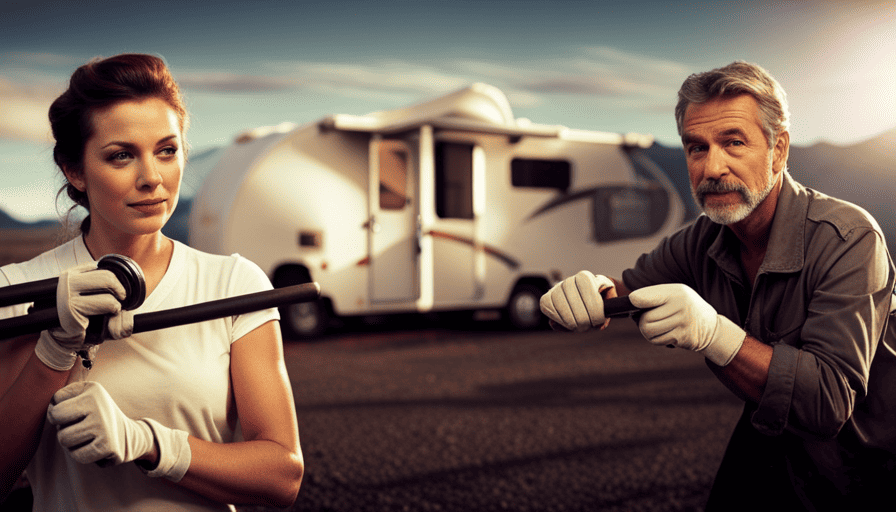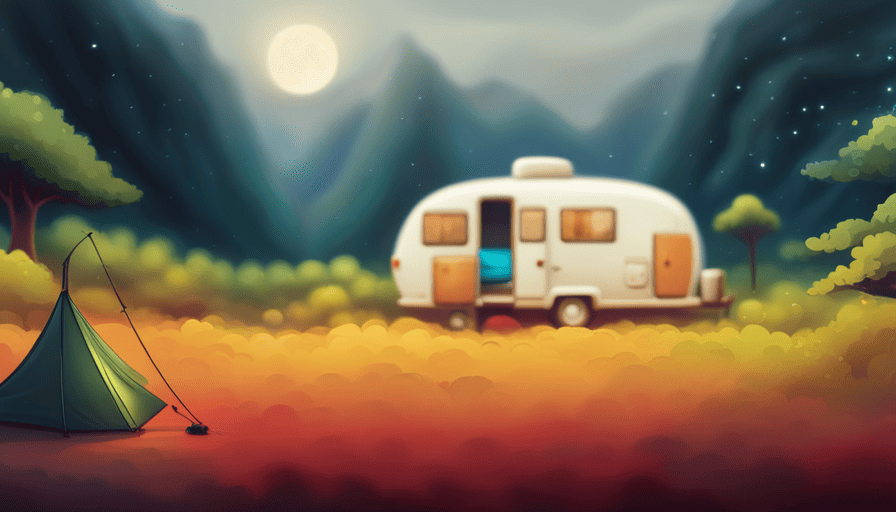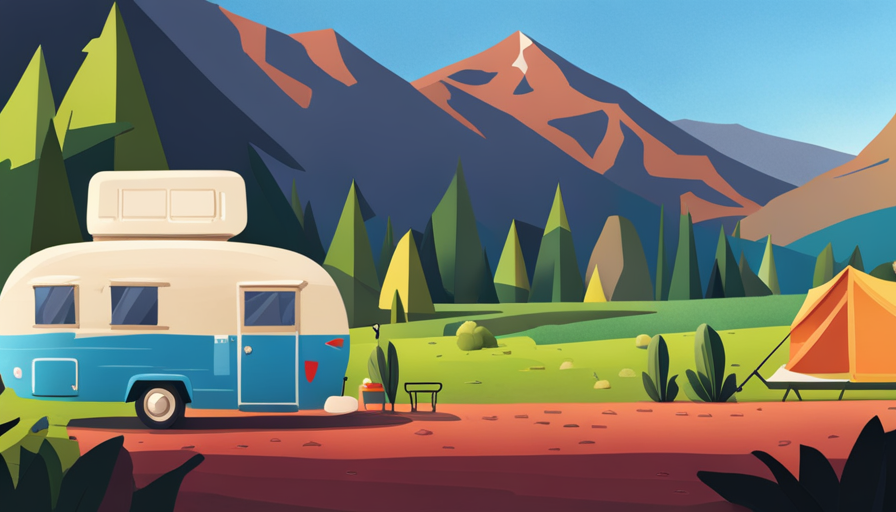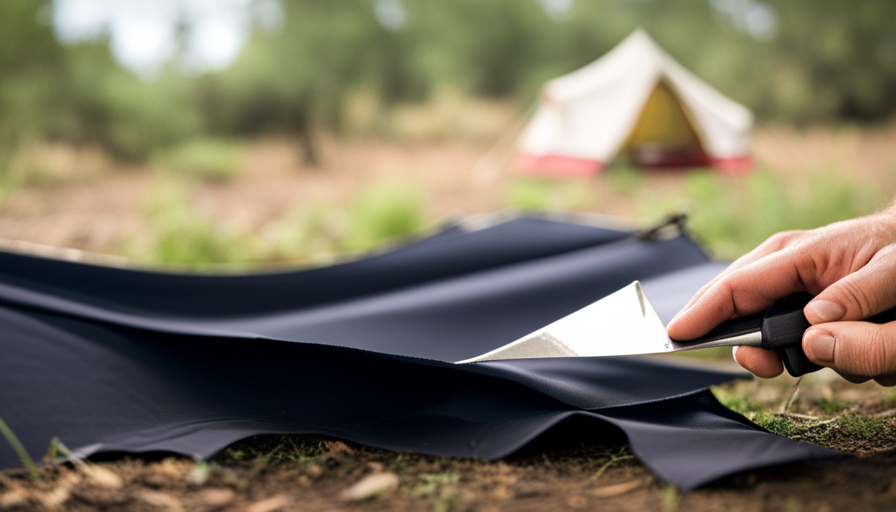By a stroke of fate, just as I set off on a national road trip in my dependable camper, I ran into a bothersome problem – a dripping water system. Intent on fixing this complication and guaranteeing a smooth trip moving forward, I immersed myself in learning about replacing water pipes in campers.
In this informative article, I will guide you through the step-by-step process of changing water pipes in your own camper, providing you with the technical know-how and detailed instructions necessary for a successful repair.
Before diving into the project, it is essential to assess the condition of your current water pipes and gather the necessary tools and materials. Once prepared, we will turn off the water supply, drain the system, and carefully remove the old pipes.
To ensure stability and prevent future leaks, we will secure the new pipes with clamps or brackets. A thorough testing for leaks will then be conducted, followed by the reconnection of the water supply.
By following these steps, you can enjoy a leak-free water system and embark on your next adventure with peace of mind. So, let’s get started on this transformative journey of replacing water pipes in your camper!
Key Takeaways
- Regularly inspect water pipes for damage such as cracks, corrosion, or loose fittings.
- Gather necessary tools such as pipe cutter, pipe wrench, and PEX crimping tool, as well as materials like PEX tubing, fittings, insulation, and hangers.
- Follow the process of turning off the water supply, draining the water system, removing the old water pipes, and installing the new water pipes. Secure the new pipes with clamps or brackets.
- Test for leaks by visually inspecting connections and joints, using a pressure gauge, applying soapy water, adding food coloring to the water tank, and listening for unusual sounds. Reconnect the water supply, tighten fittings if needed, and implement preventive maintenance by regularly inspecting and flushing the water system. Troubleshoot issues like low water pressure or strange taste/odor by checking for clogs, cleaning/replacing the water filter, and inspecting connections and fittings for persistent leaks.
Assess the Condition of Your Water Pipes
Now that you’ve settled into your cozy camper, it’s time to give those water pipes a good old inspection. It’s important to regularly assess the condition of your water pipes to ensure they’re in good working order and to prevent any potential leaks or damage.
To inspect the pipes, start by visually examining them for any signs of damage, such as cracks, corrosion, or loose fittings. Run your fingers along the pipes to feel for any irregularities or soft spots that could indicate a problem.
Additionally, check for any water stains or dampness around the pipes, as this could be a sign of a hidden leak. If you notice any of these signs, it’s crucial to address them promptly to avoid further damage.
Once you’ve inspected the pipes and identified any issues, you can then move on to the next step of gathering the necessary tools and materials for replacing or repairing the damaged pipes.
Gather the Necessary Tools and Materials
First, you’ll need to gather all the essential tools and materials required for this task, ensuring you have everything at your fingertips to successfully renovate your camper’s plumbing system. Replacing water pipes in a camper can be a cost-effective solution to fix any leaks or damaged pipes.
To begin the process, you’ll need a few key tools, including a pipe cutter, pipe wrench, PEX crimping tool, and a tape measure. Additionally, you’ll require materials such as PEX tubing, PEX fittings, pipe insulation, and pipe hangers.
To start the installation, measure and cut the PEX tubing according to the desired length. Use the pipe cutter to make precise cuts.
Next, connect the PEX tubing to the existing plumbing system using PEX fittings. Ensure a secure connection by using a PEX crimping tool to crimp the rings onto the fittings. Remember to insulate the pipes with pipe insulation to prevent freezing during colder temperatures.
Finally, secure the pipes in place using pipe hangers.
Transitioning into the subsequent section, it’s crucial to turn off the water supply before proceeding further to ensure a safe and successful installation.
Turn off the Water Supply
Before diving into this task, it’s important to shut off the water supply to ensure a safe and successful installation. Here are the steps to turn off the water supply in your camper:
-
Locate the main water shut off valve: The valve is usually located near the water pump or the water heater. It may also be found in an exterior compartment or underneath the camper. Consult your camper’s manual or contact the manufacturer for exact location information.
-
Turn the valve clockwise: Once you’ve located the valve, use a wrench or pliers to turn it clockwise to close it. This’ll stop the flow of water into your camper’s plumbing system.
-
Check for water pressure: After closing the valve, open a faucet inside the camper to check if any water is still flowing. If water continues to flow, there may be another shut off valve that needs to be closed.
-
Release any remaining water pressure: To ensure all water is turned off, open all faucets and drain any water from the system. This’ll prevent any residual water from causing damage during the pipe replacement process.
By shutting off the water supply, you’ve taken the first step towards changing the water pipes in your camper. Now, let’s move on to draining the water system to prepare for the next phase of the installation.
Drain the Water System
To properly prepare for the next phase of the installation, be sure to thoroughly flush out the fluid-filled system in your mobile home. Flushing the water system is an essential step to ensure that any remaining water is drained and the pipes are clear of any debris or contaminants. Additionally, sanitizing the water pipes is crucial to ensure clean and safe water for your camper.
To effectively flush and sanitize the water system, follow these steps:
- Turn off the water supply to the camper.
- Open all faucets, including both hot and cold water taps.
- Locate the low point drains and open them to allow the water to drain completely.
- Once the water has drained, close all the faucets and drains.
- Mix a solution of water and bleach (1/4 cup of bleach for every 15 gallons of water in the system).
- Pour the bleach solution into the fresh water tank and run the water pump until the solution comes out of all the faucets.
- Let the solution sit in the pipes for at least 12 hours to disinfect.
- Finally, flush the system by running fresh water through all the faucets until the bleach smell is gone.
To successfully remove the old water pipes and continue with the installation, follow the next section about removing the old water pipes.
Now, let’s move on to the subsequent section about removing the old water pipes without delay.
Remove the Old Water Pipes
Now it’s time to get rid of the outdated plumbing and make way for the new and improved water system in your mobile home. Removing the old water pipes in a camper can be a challenging task, but with the right approach, it can be done efficiently.
Proper disposal of the old water pipes is essential to ensure environmental safety. Start by turning off the water supply and draining any remaining water from the system.
Next, locate the connection points of the old pipes, which are typically found near the sink, shower, and toilet. Use a pipe cutter or hacksaw to carefully cut the pipes into manageable sections. Be cautious of any potential challenges such as tight spaces or corroded fittings.
Once the pipes are cut, remove them one section at a time, being mindful not to damage surrounding structures. Dispose of the old pipes responsibly by recycling them at a local recycling center or contacting your waste management provider for guidance.
With the old pipes removed, it’s time to move on to the next step: installing the new water pipes.
Install the New Water Pipes
Once you’ve successfully removed the outdated plumbing, it’s time to bring in the new and improved water system for your mobile home. Now, let’s dive into the process of installing the new water pipes.
To start, gather all the necessary materials, including the new pipes, fittings, and connectors. Measure and cut the pipes to the appropriate lengths, making sure to leave enough room for the fittings. Use a pipe cutter for clean and precise cuts.
Next, install the fittings onto the pipes by applying plumber’s tape to the threads and tightening them securely.
Once the fittings are in place, it’s time to connect the appliances. Determine the appropriate location for each appliance and install the necessary fittings to connect them to the water pipes. Use a wrench to tighten the connections, ensuring they’re leak-proof.
After all the fittings are securely connected, it’s important to test the system for any leaks. Turn on the water supply and check for any signs of leakage around the fittings and connections. If any leaks are found, tighten the fittings or connectors as needed.
With the new water pipes installed and the appliances connected, the next step is to secure the pipes with clamps or brackets. This ensures that they remain in place and don’t move or cause any damage.
Secure the Pipes with Clamps or Brackets
To ensure the stability and longevity of your new plumbing system, it is crucial to securely fasten the pipes using clamps or brackets. When it comes to securing water pipes in a camper, you have two options: clamps or brackets. Both options have their pros and cons, so it’s important to choose the one that best suits your needs.
Clamps are a popular choice for securing water pipes in campers. They are easy to install and provide a secure grip on the pipes. Clamps come in various sizes and materials, such as stainless steel or plastic. They are adjustable, allowing you to tighten or loosen them as needed. However, clamps can sometimes cause pressure points on the pipes, leading to leaks over time.
On the other hand, brackets offer a more rigid support for the pipes. They are typically made of metal and provide additional stability. Brackets can be mounted to the walls or the floor of the camper, depending on your preference. While brackets offer excellent support, they can be more challenging to install and may require drilling into the camper’s structure.
Whether you choose clamps or brackets to secure your water pipes, it’s essential to consider the pros and cons of each option. Once you have securely fastened the pipes, the next step is to test for leaks in your new plumbing system.
Test for Leaks
Make sure you give your new plumbing system a thorough check to ensure everything’s dry and secure. Here are some key steps to follow when testing for leaks and troubleshooting water pipe issues:
-
Visual Inspection: Carefully examine all the connections and joints in your water pipe system for any signs of water leakage. Look for puddles, drips, or damp areas.
-
Pressure Test: Use a pressure gauge to check the water pressure in your system. If the pressure’s too high or too low, it can lead to leaks. Adjust the pressure accordingly.
-
Soap and Water Test: Apply a mixture of soapy water to the connections and joints. If bubbles form, it indicates a leak. Tighten or replace the faulty connection.
-
Dye Test: Add a few drops of food coloring to the water tank and run the system. If the water in the pipes changes color, there might be a leak.
-
Listen for Sounds: Turn on the water supply and listen for any unusual sounds like hissing or dripping. These noises can indicate a leak.
By following these steps, you can effectively detect and address any leaks or issues in your water pipe system.
Once you’ve completed the testing process, you can move on to the next step of reconnecting the water supply.
Reconnect the Water Supply
After conducting a thorough test for leaks in your camper’s water pipes, it’s time to move on to the next step: reconnecting the water supply. This crucial task involves two key components: the water pump and the faucets.
To begin, locate the water pump, which is typically situated near the fresh water tank. Ensure that the pump is securely connected to the main water line. Use the appropriate fittings and connectors to achieve a tight and leak-free connection.
Once the water pump is properly reconnected, it’s time to focus on the faucets. Remove the old faucets and replace them with new ones specifically designed for campers. These faucets are typically compact and lightweight, making them ideal for the limited space in your camper. Connect the new faucets to the water lines, ensuring that they are tightly secured to prevent any leaks.
By reconnecting the water pump and installing new faucets, you are taking important steps towards restoring your camper’s water system. With these tasks completed, you can now move on to the subsequent section and enjoy the benefits of a leak-free water system in your camper.
Enjoy Your Leak-Free Water System
Now that you’ve successfully reconnected the water supply and installed new faucets, it’s time to sit back, relax, and enjoy the benefits of your leak-free water system in your camper. No more worries about water damage or wasting precious water resources.
To ensure that your water system remains in top condition, it’s important to implement preventive maintenance and have troubleshooting techniques in place.
Here are three key preventive maintenance steps to keep your water system running smoothly:
-
Regularly inspect all water pipes for any signs of wear or damage. Look for cracks, leaks, or loose fittings. Replace any faulty parts immediately to prevent further damage.
-
Keep your water system clean by flushing it regularly. This will help remove any debris or sediment that may accumulate over time and cause blockages or damage to the pipes.
-
Protect your water system from freezing temperatures. Insulate exposed pipes and consider using a heat tape or portable heater to prevent freezing and bursting.
In case you encounter any issues with your water system, here are a few troubleshooting techniques:
-
If you experience low water pressure, check for any clogs or obstructions in the pipes or faucets. Clean or replace any faulty components.
-
If you notice a strange taste or odor in your water, it could indicate a problem with your water filter. Replace the filter or clean it according to the manufacturer’s instructions.
-
If you have a persistent leak, carefully inspect all connections and fittings. Tighten or replace any loose or damaged parts.
By following these preventive maintenance steps and troubleshooting techniques, you can ensure that your camper’s water system remains in optimal condition, allowing you to enjoy a leak-free and refreshing water supply during your camping adventures.
Frequently Asked Questions
How do I determine the condition of my water pipes in a camper?
To determine the condition of water pipes in a camper, inspecting them is crucial. Start by examining visible pipes for any signs of damage such as cracks, leaks, or corrosion.
Check for water stains or dampness around fittings and connections. Use a flashlight to inspect hidden areas and look for any bulges or discoloration.
Ensure proper water pressure and flow by turning on all faucets and running the water. If you notice any issues, it may be time to replace the water pipes in your camper.
What tools and materials do I need to change the water pipes in a camper?
To change the water pipes in a camper, you’ll need several tools and materials. First, you’ll require a pipe cutter to remove the old pipes. Additionally, you’ll need a wrench to loosen and tighten the fittings. Other essential tools include a tape measure, PVC primer, and cement for sealing the connections, and Teflon tape for securing the threads.
You’ll also need new water pipes, fittings, and clamps to complete the replacement process.
How do I turn off the water supply in a camper?
To turn off the water supply in a camper, locate the water pump and shut off its power source. This figurative ‘heart’ of the water system controls the flow of water throughout the camper.
Additionally, make sure to drain any remaining water from the system to prevent freezing during winter months.
To fix a leaky faucet, identify the source of the leak and replace any damaged parts or seals.
Properly winterizing a camper is essential for maintaining its water system.
How do I drain the water system in a camper?
To drain the water system in a camper, start by turning off the water supply and opening all faucets and valves to release any remaining water.
Next, locate the drain valve, usually located near the water tank. Attach a hose to the valve and direct it away from the camper. Open the drain valve and let all the water drain out.
This is an essential step in properly winterizing a camper and ensuring a sanitized water system.
How do I test for leaks after installing the new water pipes in a camper?
To test for leaks after installing new water pipes in a camper, there are a few testing methods and troubleshooting tips you can follow. Firstly, pressurize the water system by connecting it to a water source and turning on the pump.
Inspect all connections, joints, and fittings for any signs of water leakage. Additionally, use a water leak detector or a soapy water solution to identify any hidden leaks.
Address any issues promptly to ensure a properly functioning water system.
Conclusion
In conclusion, changing water pipes in a camper can be a daunting task, but it can be accomplished successfully with the right tools and materials. Here’s how:
- Assess the condition of your water pipes.nn2. Turn off the water supply.nn3. Remove the old pipes.nn4. Secure the pipes with clamps or brackets.nn5. Test for leaks to ensure durability.nn6. Reconnect the water supply.nn7. Enjoy the convenience of a functioning water system in your camper.










